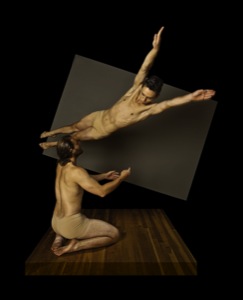
Malashock Dance takes on bullying with the return of ‘RAW’
BY ANDREW PRINTER
October is Bullying Prevention Awareness Month. It’s also time for the return of Malashock/RAW the popular program brought to you by Malashock Dance. This time around Malashock/ RAW3 includes a work titled Bully choreographed by Associate Artistic Director Michael Mizerany. The inclusion of this piece was not entirely coincidental. All three dances in the RAW3 set seem to involve power struggles but the presentation of Bully continues the company’s awareness of issues relevant to the LGBT community.
The dance company is aware of a responsibility to open up the topic. After the Oct. 27 performance Malashock Dance hosts an audience talk back and panel discussion about bullying that includes dancers, dance educators and local experts on the topic. Featured panelists include Walter G. Meyer author of Rounding Third, a novel that deals with teens being bullied until one of them can’t take it any longer and attempts suicide. Audience members have an opportunity to join the discourse.
I had a conversation with Michael Mizerany about Malashock/RAW3, about his Bully and about bullying in general.
San Diego LGBT Weekly: Malashock/ RAW3 promises “beautiful, cutting-edge and provocative new works, poised to out-shock and out-delight audiences.” What can audiences expect with this third iteration in the RAW series?
Michael Mizerany: Malashock/RAW is our most daring, dynamic and bold production of the season. Audiences can expect to have both a visual and visceral experience. If I had to steal a quote from one of our hardcore patrons, it would have to be: “Raw is sweat, skin and non-stop, no-holds-barred energy. RAW is Rawsome!” During our third year, the new dance work will tackle many controversial themes; will include some nudity, physical danger as well as stellar performances by the Malashock Dance company members.
Your piece is titled Bully. Is it a theme that permeates all three works?
The theme of bullying applies only to my work. The other two works by John Malashock and Regina Klenjoski address other subject matters and themes. Though, having seen their dances, there are definitely elements which could be construed as bullying.
October is Bullying Prevention Awareness Month. What can dance bring to the conversation?
This issue has been on my radar for quite some time.
Much of the bullying I experienced was based on homophobia, machismo and antiquated ideas of male identity. I was searching for a way to not only address bullying in general, but what I felt were some of the causes.
Malashock/RAW provided me with the perfect opportunity. My approach to Bully will surprise many members of the audience, both in content and structure. It is atypical, satirical, violent and, when the two main characters finally come together, very poignant.
Is there an attempt to invite younger people to the performance, perhaps those involved in on-campus gay/straight alliances etc?
Yes, we are reaching out to gay/straight alliances, The Gay and Lesbian Center, and other artistic and education institutions. With the advent of social media sites, especially Facebook, schoolyard bullying has been taken into the cyberspace and is more extreme than ever.
Though, bullying doesn’t just happen in the schoolyard. It can occur in the work place and interpersonal relationships. That, I believe, is the ripple effect.
So, I don’t know if you really get past being bullied. I still have clear and distinct memories of being harassed. Those scars tend to run deep. Those experiences define how you react and interact with people in your adult life. It has a long-term effect. Sometimes, it is something you can live with but you don’t always recover completely. And tragically, many people, especially teens, find they can’t live with it at all.
What was your experience with bullying at school and how did that influence you as a choreographer?
I went to a Catholic School for 9 years. Most of those years were spent fending off bullies. I was harassed verbally and physically and it took a tremendous toll on my school work and self-esteem. In my sophomore year of high school, my parents enrolled me in public school. It saved my life. I was embraced by the theater and dance community and found a place where my differences were celebrated and embraced.
I don’t know if the “bully” psychology is relevant, but my work does tend to be dark. My RAW piece last year, Desperate Love, followed a young man as he searched for the ideal love. He sacrificed his friendships, morals, ethics and body only to end up alone. Once you have surrendered everything you are, how can you find love or be loved? I know, dark, right?
Malashock Dance will host a panel discussion after the performance. What do you hope to accomplish with this?
I think there is tremendous power in sharing our mutual stories. It fosters meaningful solutions and allows others to understand your point of view. Will we solve the problem of bullying? Probably not. But we can pull strength and resilience from our universal experiences.
Malashock/RAW3 runs through Oct. 28, at the Malashock Dance Studio at Dance Place San Diego in Point Loma’s Liberty Station. Performances are Thursdays, Fridays and Saturdays at 8 p.m. and Sundays at 7 p.m. After the San Diego run, Malashock/RAW3 moves to the Live Arts Theater, Los Angeles, Nov. 9 and 10.











